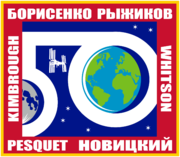ISS - Expedition 50 Mission patch.
Nov. 10, 2016
International Space Station (ISS). Image Credit: NASA
(Highlights: Week of Oct. 31, 2016) - As three crew members made their return trip to Earth, investigations continued on the International Space Station including another successful creation on the station’s 3-D printer.
NASA astronaut Shane Kimbrough removed a two-piece print of a sample container and lid made out of high-density polyethylene plastic from the Additive Manufacturing Facility (Manufacturing Device), installed on the station in 2015. The Manufacturing Device is a 3-D printer that uses additive manufacturing to build a part layer by layer using an engineered plastic polymer as raw material. Kimbrough reported that the parts adhered well to the print surface, ensuring a solid build. Soon afterward, the ground team commanded the printer to use the same material to create another sample to learn about the plastic’s tensile strength.
Image above: A tiny bud is one of a handful of lettuce plants growing on the International Space Station as part of the Veg-03 investigation, finding better ways to grow fresh food in orbit so astronauts will have healthier sustenance on long space journeys. Image Credit: NASA.
The Manufacturing Device is another step toward a permanent manufacturing capability on the space station. It will enable the production of components and tools on demand in orbit, which will provide further research into manufacturing for long-term missions. The station crew can use it to print a variety of items to perform maintenance, build tools and repair sections in case of an emergency, leading to a reduction in cost, mass, labor and production time. Further research will also help develop this advanced technology for use on Earth.
Ground teams continued another round of the Advanced Colloids Experiment-Temperature Control (ACE-T-1) study. For decades, astronauts and scientists have studied complex structures with unique properties in space. The station's microgravity environment allows for the study of microscopic structures in three dimensions without the potentially distorting properties of gravity. The ACE-T-1 investigation examines tiny suspended particles designed by scientists to connect themselves in a specific way to form organized structures in water.
Kimbrough began his flight day 15 human research activities, by collecting blood and urine samples for the Biochemical Profile (Biochem Profile) investigation. The astronauts study themselves to learn how the human body reacts to long-duration spaceflight. Biochem Profile tests bodily fluid samples obtained from astronauts before, during and after spaceflight. Specific proteins and chemicals in the samples are used as biomarkers, or indicators of health. Post-flight analysis yields a database of samples and test results, which scientists can use to study the effects of spaceflight on the body. Establishing a chemical profile of the body’s response to spaceflight will help scientists understand how different systems in the body interact in microgravity in different groups of people. Scientists can also test the effectiveness of possible countermeasures like exercise and nutrition and their effects on crew health during long-duration exploration missions.
October Highlights
Video above: October saw three new crew members aboard a Soyuz spacecraft and a Cygnus resupply ship launch to the space station before another crew landed after 115 days in space. Video Credit: NASA.
An improved understanding of the biochemical effects of microgravity could help patients with limited mobility on Earth, such as those on bed rest. Understanding how various physiological systems respond and interact to changing gravity conditions could help physicians design different treatments or exercises for people with limited mobility.
While settling in to the space station, Kimbrough conducted other human research investigations this week, including Dose Tracker and Space Headaches.
Progress also was made on other investigations and facilities this week, including Veg-03, Meteor, ISS Ham, Group Combustion.
Related links:
Manufacturing Device: http://www.nasa.gov/mission_pages/station/research/experiments/2198.html
Advanced Colloids Experiment-Temperature Control (ACE-T-1): http://www.nasa.gov/mission_pages/station/research/experiments/2033.html
Biochem Profile: http://www.nasa.gov/mission_pages/station/research/experiments/1008.html
Dose Tracker: http://www.nasa.gov/mission_pages/station/research/experiments/1933.html
Space Headaches: http://www.nasa.gov/mission_pages/station/research/experiments/181.html
Veg-03: http://www.nasa.gov/mission_pages/station/research/experiments/1294.html
ISS Ham: http://www.nasa.gov/mission_pages/station/research/experiments/346.html
Group Combustion: http://www.nasa.gov/mission_pages/station/research/experiments/1077.html
Space Station Research and Technology: https://www.nasa.gov/mission_pages/station/research/index.html
International Space Station (ISS): https://www.nasa.gov/mission_pages/station/main/index.html
Images (mentioned), Video (mentioned), Text, Credits: NASA/Vic Cooley, Lead Increment Scientist Expeditions 49 & 50/Kristine Rainey.
Best regards, Orbiter.ch



